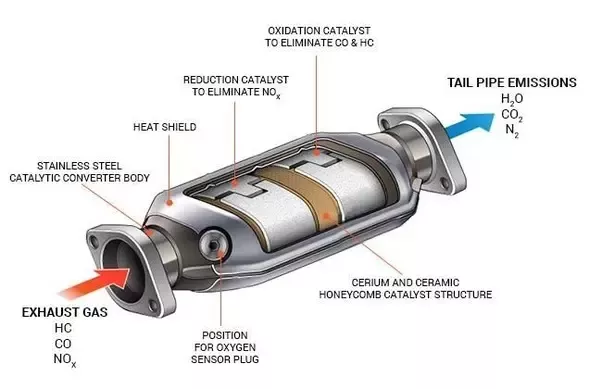Catalytic converters are an essential component of a vehicle’s exhaust system, and they play a vital role in reducing emissions and improving air quality.
These devices are made up of several different materials, each of which serves a specific purpose. In this article, we will take a closer look at the materials that are commonly used in catalytic converters and their features.
Different Materials Used in Catalytic Converters
There are several different materials that are used in the construction of catalytic converters, including metals, ceramics, and other specialized materials. Some of the most common materials used in these devices include:
Platinum
- Platinum: Platinum is a precious metal that is widely used in catalytic converters due to its high catalytic activity. It is able to effectively convert harmful exhaust gases into less harmful substances, making it an important component of the catalytic converter.
Palladium
- Palladium: Palladium is another precious metal that is commonly used in catalytic converters. It is less expensive than platinum and has similar catalytic properties, making it a popular choice for use in these devices.
Rhodium
- Rhodium: Rhodium is another precious metal that is used in catalytic converters. It is highly resistant to corrosion and has a high melting point, making it a durable choice for use in these devices.
Ceramics
- Ceramics: Some catalytic converters are made up of a ceramic substrate, which serves as a support structure for the catalytic material. Ceramics are heat-resistant and durable, making them an ideal choice for use in these devices.
Features of Common Catalytic Converter Materials
- Platinum, palladium, and rhodium are all highly effective at converting harmful exhaust gases into less harmful substances.
- These metals are resistant to corrosion and have high melting points, making them durable choices for use in catalytic converters.
- Ceramic materials are heat-resistant and durable, making them an ideal choice for use in catalytic converters.
Catalytic Converters parts and their functions
Catalytic converters are an essential part of a vehicle’s exhaust system, and they are designed to reduce emissions and improve air quality by converting harmful gases into less harmful substances.

These devices are made up of several different parts, each of which serves a specific function. Some of the main parts of a catalytic converter and their functions are:
Substrate:
- Substrate: The substrate is the main structure of the catalytic converter, and it is typically made up of a ceramic or metallic material. The substrate provides a support structure for the catalytic material and helps to hold the device in place.
Catalytic material
- Catalytic material: The catalytic material is the main component of the catalytic converter, and it is responsible for converting harmful exhaust gases into less harmful substances. This material is usually made up of precious metals such as platinum, palladium, and rhodium, which have high catalytic activity.
Inlet pipe
- Inlet pipe: The inlet pipe is the part of the catalytic converter that connects to the exhaust pipe of the vehicle. It is through this pipe that exhaust gases enter the catalytic converter.
Outlet pipe
- Outlet pipe: The outlet pipe is the part of the catalytic converter that connects to the muffler or tailpipe of the vehicle. It is through this pipe that the converted exhaust gases exit the catalytic converter.
Heat shield
- Heat shield: The heat shield is a protective layer that surrounds the catalytic converter and helps to protect it from heat damage. The heat shield is typically made up of a heat-resistant material such as stainless steel or aluminum.
Gaskets
- Gaskets: Gaskets are used to seal the joints between different parts of the catalytic converter, helping to prevent leaks and ensure that the device functions properly.
Overall, these are the main parts of a catalytic converter and their functions. Together, these parts work to effectively convert harmful exhaust gases into less harmful substances, helping to reduce emissions and improve air quality.
Conclusion
Catalytic converters are an essential component of a vehicle’s exhaust system, and they play a vital role in reducing emissions and improving air quality.
These devices are made up of several different materials, including metals such as platinum, palladium, and rhodium, as well as ceramics and other specialized materials.
Each of these materials has its own unique properties and features that make it well-suited for use in catalytic converters.





